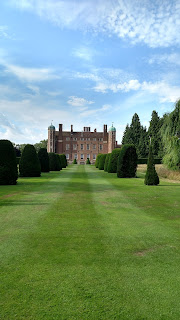Timing is everything but luck almost always has a hand in it. That was our case as we moved on to Canterbury. While in Dover we learned of King Henry II. Now in Canterbury we would come face to face (literally) with one of his most infamous acts.
Canterbury is the home of Canterbury Cathedral, mother church of the Anglican community and the
 |
| Becket's shrine is marked by a lamp |
The site of Beckets shrine is said to be the location where miraculous healings have occured. The cathedral itself has many stained glass windows depicting healing attributed to him either from dreams, drinking water mixed with his blood or through prayer. So many pilgrims traveled to this place that it became the inspiration for Geoffrey Chaucer's work, The Canterbury Tales. Many of these pilgrims from Europe would spend the night at Dover Castle after crossing the Channel before travelling on to Canterbury. The shrine itself was destroyed on the order of Henry VIII during the English Reformation in 1538. Whether his bones and ashes were removed and destroyed by the soldiers or whether they were retrieved and hidden by monks is a mystery of history. Although some speculation that a certain unmarked grave in the cathedral crypt holds the re buried remains, any investigation has proven to be inconclusive.
So what does this have to do with Henry II?
The day we arrived in Canterbury was the day the city re-enacts the penance of Henry II. Henry was accused of having Becket killed due to disagreements over the power of the King vs. the Church. Henry claimed that his knights acted alone but agreed to perform a ceremony of public penance to avoid excommunication. So there we were in downtown Canterbury watching as the “King” walked barefoot over cobblestones in a burlap shift throughout the town, periodically making speeches declaring his innocence. At the end he goes inside a church, as the real King did, to be flogged by Monks.( I don’t think our actor was actually flogged, he looked pretty good at a pub that afternoon)
| Sorry, not sorry |








